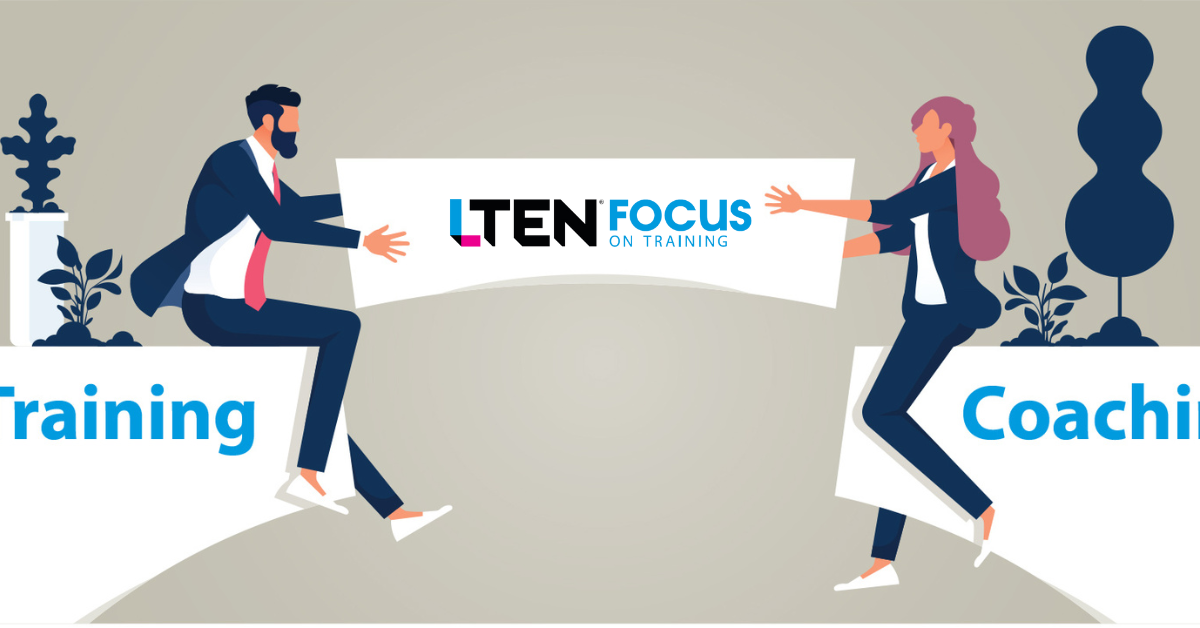
Coaching – By Alison Muller
Understanding the distinction can help head off a pervasive problem
Sometimes a small nuance can create a large impact, like the distinction between training and coaching, especially in a unique and highly regulated industry like life sciences. While training is a transfer of knowledge and skills, coaching takes what was learned and applies it to real world scenarios in personalized and effective ways for the greatest impact.
Some life sciences organizations are conflating the two and not giving proper focus to the importance of coaching. Others understand the distinction but have the critical functions of training and coaching siloed in different departments.
In either scenario, this disconnect is contributing to a pervasive problem.
Unapproved Information
A recent research study revealed that 74% of commercial learning and development (CL&D) professionals believe that their field teams are using unapproved content or messaging in their interactions with healthcare providers(HCPs). Of the 192 survey respondents, 93% who encountered field reps using unapproved content and messaging indicated that it had a direct negative impact on their company.
This behavior can create legal or compliance issues and tarnish brand reputation, but the biggest concern, as noted by survey respondents, is the negative impact sharing unapproved information can have on patient safety. Unlike other industries, mistakes made by reps in the life sciences industry directly impact human life, so eliminating this behavior could quite literally save lives.
Organizational silos fuel some of this behavior — brand teams, CL&D, product and compliance teams all serve different functions when it comes to equipping field representatives with the information needed to do their jobs. In many cases, these departments are not working together, so there’s a higher potential for risk, and that becomes clear when reps head out into the field.
Real Talk
Given this organizational disconnect, the survey revealed a few eye-opening realities:
- First, field reps are largely unaware of the risks associated with using unapproved messaging or content.
- Second, there is a lack of a continuous learning culture, so once training is over, reps are essentially on their own aside from monthly or sometimes quarterly ride-alongs with their managers.
- Last, the materials provided by brand and marketing are too complex andhard to find, leaving reps confused as to what they should use with HCPs.
As an audience member in a recent webinar with Citeline (the organization that conducted the research) pointed out, “I think field reps don’t use unapproved material but use approved material to convey an inappropriate message.”
Again, this nuance is of critical importance. Marketing invests time and money to create approved assets, which training teams leverage to teach their reps. The reps get trained but aren’t necessarily coached (or continuously coached) on how to speak to them.
Additionally, reps often struggle to find those approved materials after training, so even if they intended to use the material, they aren’t able to. So when they go out to the field, they don’t fully understand the repercussions of inaccurately representing the material, inadvertently putting themselves, their organization and, ultimately, patients at risk.
The Right Stuff
In addition to these potential risks, there are other more qualitative things to consider, like HCP perception. In another survey, 70% of HCPs felt that pharma reps “do not completely understand their needs and expectations.”
This could also be, in part, because reps aren’t being properly coached on how to speak to their HCPs with both accuracy and personalization. HCPs want to rely on reps as a trusted resource and have their questions and concerns answered specifically, not with a one-size-fits-all approach, which further highlights how field teams are missing the mark.
Again, unlike other industries, field reps in life sciences need to understand and convey complex information regarding therapies that will directly impact humans. This is a significant responsibility and one that can’t be taken lightly.
The good news is that there is a way forward. In the Citeline survey, when asked what the most effective strategies to eliminate the use of unapproved content and messaging were, survey respondents said implementing and upholding a continuous learning culture, making content and information easy to digest, and having information centralized would make a significant difference.
Accessing Approved Content
So, how does understanding the distinction between training and coaching play a role in the above? Many people in the industry believe that training is fragmented from a departmental and a technological standpoint. This makes learning, retaining information and effectively leveraging what you’ve learned difficult.
Reps may need to access one tool for approved marketing content, another to refer to training material, and yet another for scenario coaching and role-playing exercises. Sometimes these departments do not speak to one another and, therefore, may not be speaking the same language to the reps.
If you’re familiar with The Forgetting Curve model developed by Herman Ebbinghaus, you know that learners forget up to 90% of what they’ve learned within seven days of learning it. Pharma reps may wish to reference training assets to refresh their memory, but they struggle to find them. And, on top of that, they receive limited coaching to reinforce what they’ve learned, so the forgetting curve wins.
Between not remembering what they’ve learned and not being able to effectively convey the right message to their HCPs, the reps’ rate of success is threatened and there is an increased chance of exposing the organization to legal and compliance risks.
The Culture Connection
Organizations can drastically reduce their risk and fundamentally improve performance by implementing a continuous learning culture. A continuous learning culture is one where learning is an ongoing process supported by management and employees.
It’s an environment where learning is looked at as more than just a one-time event and where employees are encouraged to seek out knowledge and skills to advance their careers. Information is easily accessible, and employees are provided with the tools, technology, infrastructure and opportunities to apply what they’ve learned.
The keys to operating a continuous learning culture lie in cross-functional collaboration, consistency of information and tools across departments, and implementing proactive and ongoing coaching that includes learning, resources, field coaching and scenarios, field coaching reports and certifications in one place.
Given that much of the risk lies in the messaging that makes its way from a rep to an HCP, finding ways to overcome that challenge are of the utmost importance. This is where utilizing coaching in a continuous and connected learning environment becomes critical.
In most of today’s coaching environments, there isn’t much depth of visibility to where coaching needs truly lie — managers are unable to easily identify or address gaps in knowledge, and coaching is reduced to a validation exercise to evaluate knowledge and check the box.
Because training has concluded and a rep has been certified by the time coaching begins, it’s even harder to identify those moments of need when it comes to their delivery of messages to the market. Coaching becomes an afterthought and occurs after a rep is already in the field talking to HCPs.
When training and coaching happen in silos with no connected strategy in place, it becomes increasingly difficult to employ corrective behavior to stop unapproved and off-label messaging.
Strategies & Scenarios
There are some basic strategies that can help mitigate this risk. Organizations committed to stopping the use of unapproved messaging and content in the field should consider immediate training reinforcement within 48 hours of training sessions and provide key takeaways and summaries to their learners. This improves retention and reinforces approved content and messaging.
Additionally, providing ongoing interaction in the field through scenario and video coaching, ride-alongs and best practice sharing on a regular basis is important —not just once a month or once a quarter, but as needed. Allowing reps to request coaching when they need it around specific topics also supports learning retention and proper messaging.
Lastly, ensure the learning assets that marketing and training teams produce get pulled through to real-world scenarios. Make these assets easy to access, easy to digest and integrated into both learning sessions and coaching scenarios.
Doing one without the other — separating training and coaching — creates a divide that can cause major issues for organizations and, more importantly, pose risk to patients.
Conclusion
Understanding the distinction between training and coaching is crucial, as they serve different purposes — one focuses on knowledge sharing, while the other on knowledge application. However, it is equally important not to keep them isolated from each other.
Breaking down the barriers between knowledge sharing and application, especially when it comes to life sciences, can equip sales representatives with the necessary tools to safely communicate with HCPs more confidently, which can lead to building stronger and more trusted relationships with them. This, in turn, could prove pivotal in enabling life sciences organizations to make significant strides toward ensuring patient safety, compliance and commercial success.
 Alison Muller is chief marketing officer for ACTO. Email Alison at alison@actoapp.com.
Alison Muller is chief marketing officer for ACTO. Email Alison at alison@actoapp.com.









